| | | 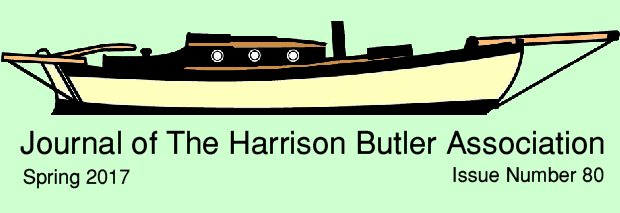

Yoldia underway in the Swedish Archipelago, Summer 2016
Photograph courtesy of Rutger Palmstierna
The Journal of The Harrison Butler Association
Editor : Martin Hansen
Proof Reading : Dr Helen Jones
Far East Correspondent : Dr Stephen Davies
Australian Correspondent : v a c a n t
Netherlands Correspondent : Michiel Scholtes
Baltic Correspondent : Myriam Spicka
UK Correspondent for The Solent : Robert Griffiths
UK Correspondent for Dartmouth : Allen Clarke
Contributions for the Journal are most welcome be they
fully formed articles, rough notes or snippets of News.
If you feel you would like to contribute on a regular basis,
applications to join our growing network
of correspondents are also invited.

The biggest killer of a wooden yacht is not storm at sea, fire down below, catastrophic navigational error, or collision with another boat. It is simply leaving the boat out, uncovered and unattended, exposed to wind and rain. Fresh water will find a way in and cause mould and rot. The deck will turn green with algae. A previously fine boat, without a canvas cover, neglected for five years, will be difficult to save. My plea to all wooden boat owners; when not being sailed, cover her up.
A major factor often not mentioned to prospective wooden boat owners is that with the boat comes the necessity to maintain a canvas cover. This certainly did not figure in my calculations when I bought Tramontana. However, she came with a midships-to-stern canvas cover and midships-to-bow plastic tarpaulins. I mirrored the previous owners fastidiousness about using them when not sailing. At first I thought the rational behind this was to compensate for the many deck leaks which, as a new owner, I enthusiastically set about tracking down and curing. Many tubes of Sikaflex later it occurred to me that even with the deck now watertight, the covers would continue to be essential in preventing an endless list of new maintainence tasks from overwhelming me.
After two years of use, the covers that came with the boat were tattered and torn. I realised that I needed to buy and learn to use a heavy duty sewing machine. By a process of trial and improvement the existing canvas cover was extended with a skirt, and the plastic tarpaulins used as a template to obtain a complete canvas cover for the whole boat. Last year I added rucksack buckles and strapping to tension the whole affair, having realised the hard way that any slackness results in chafe when the wind is up and a tedious number of holes and tears to patch. The buckles also make it far easier to get the cover on and off quickly, rather than using knots.
I have come to think of Tramontana's canvas cover as being like the defensive shield on Star Trek's star-ship Enterprise; a first line of defence that prevents damage to the ship itself.
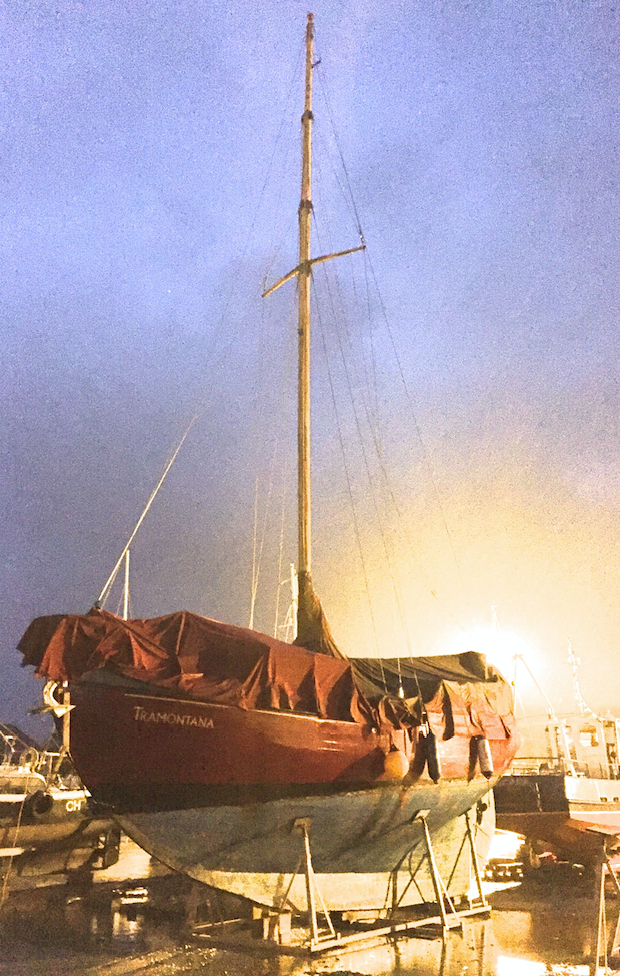
Tramontana on the hard at Fleetwood Marina, April 2017,
with her covers on during a stormy night.
Photograph by Martin Hansen

!•¡•! A member of the HBA, Hannah Cunliffe, has been announced as the new director of National Historic Ships UK to universal acclaim. Chairman John-Henry wrote to Hannah on behalf of the HBA to “send our heartiest congratulations”. Replied Hannah, “Many thanks for your kind words. I am delighted to have been offered the role and look forward to taking up the challenge over the coming months”. National Historic Ships UK provides leadership and strategic vision across the UK historic ships communities and wider maritime sectors by acting as the official voice for historic vessels pursuing proactive engagement with the sector, the UK government, the Devolved Administrations, public and private agencies, and communities at large.
!•¡•! Since the previous issue of the Journal was published, Little Kingfisher, Mary Gray, Zingara, and Zephon have been sold. Kelana has been broken up. Quest of Sidney has become available to buy but “only to the right person” !
!•¡•! The 2017 HBA AGM agreed a new set of 'more inclusive' Membership Arrangements. In particular the only requirement for becoming a member now is “an interest in the yachting designs of Dr Thomas Harrison Butler”. Memberships on offer are Single £12, Joint £16 or Family £16. The website Membership page has been updated with further detail.
!•¡•! Patrick Burgess' lavish book on the life of Geoff Taylor and his voyages in Watermaiden has been published and is available to buy through Amazon.

A New Deck For Vindilis
Richard Farmer
The HBA's South Coast Social Secretary
At the end of the 2015 season we noticed something wrong with two of the knees on Vindilis. The team at Emsworth Yacht Harbour had lifted her out and we were preparing her for her winter lay up. A half-inch gap had appeared between the knees under the forward end of the deck and the carlin beams that support the cabin side. The gaps were to both port and starboard and I knew they were recent. I discussed the problem with fellow Harrison Butler owners (including Roy Aldsworth who did such a great job on Mischief III) and also sought the advice of Andrew Oliver. Andrew is the shipwright at Emsworth who has carried out any major work on Vindilis since she came down from Scotland in 2009. We went through a number of possibilities. We knew some water was getting through the original decks so maybe rot had caused the ends of the bronze tie rods to pull through. However, we recalled that we had a couple of choppy and blustery sails towards the end of the season. The only explanation that seemed to make sense was that she was starting to flex and something needed to be done. I had previously admired some of Andrew's work on a similar project and discussed doing the same work on Vindilis. So I asked him to dust off his proposal and after a period of procrastination on my part, we agreed to start work in February 2016.
When the old deck was removed our suspicions proved correct. Many of the deck beams were loose and rattled in the beam shelf. We could see that water had also penetrated at the rear of the cabin carlin beams, at the counter stern and in other places. This had caused superficial rotting of some the deck beams but had almost destroyed the solid block of oak at the stern supporting the back-stay. We also found that the rudder tube was badly corroded and needed replacing.

A view from above, deck removed, looking down at a loose deck beam.
The foot gives an idea of scale.
The plan of work included making good and replacing oak deck beams, laying the new deck and replacing the rudder assembly. For the deck we decided to lay a sub-strata of top quality marine ply, sheath it with glass-fibre matting and then lay the original deck planks on top. The new deck thickness is about the same as the original but now made up of equal parts ply and the original teak thinned down. The end grain on the marine ply is very carefully protected with the glass-fibre sheathing and where fittings penetrate the deck. We also wanted to de-clutter the deck as much as possible, take the opportunity to paint lockers, carry out some rewiring , replace the windlass and generally carry out other work where we could now gain access easily.
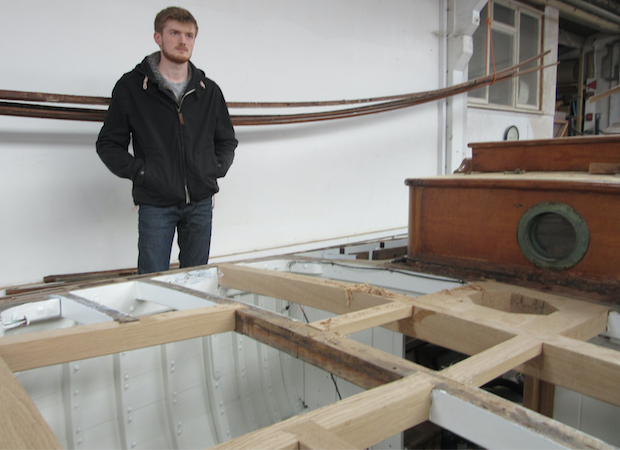
Richard's son, Jack, looks at the part refurbished,
part replacement, deck support framing.
The period from February to August 2016 was hard work but ultimately satisfying. Most weekends were spent painting, wiring and listening to Radio 6 music. I was very jealous of other Harrison Butlers who sent pictures of themselves bowling along in perfect conditions. Our intention of being back on the water in June was set back two months due to the extra work needed. However, work progressed steadily to Andy's usual meticulous standard. I also made a trip to Essex to meet Colin Frake of Faversham who has a long family association with East Coast barges, smacks and other classic boats. Colin agreed to re-galvanise the shroud plates, make a new gammon iron, a new bronze horse and boom fittings. What can I say - Colin's fittings are beautiful. He also makes fantastic wooden blocks, which I am currently saving for. The final job was to fit the new stainless steel rudder tube, shaft and tiller head. Oliver Taylor, again at Emsworth, did this to a very high standard. Vindilis was launched in August and made her first trip to Beaulieu and then to Burlsedon for the annual bank holiday regatta. She also attended the Hamble classics in September where strong winds were the order of the day (causing the helm and crew to retire rather than the boat).

The stunningly graceful curves of Vindilis' newly refurbished deck
The biggest surprise is how much stiffer Vindilis feels and how much better she sails. The decks also look and feel great and have been much admired. Importantly, they don't drip on our berths when they are wet. The original deck managed 81 years and hopefully the new one should also be good for a few years to come.
When The Engine Fails
Brian Bird
When I came across the excellent HBA website recently, I was fascinated to learn about the late Geoff Taylor and his multiple trans-Atlantic solo voyages aboard his boat Watermaiden. When Geoff was alive, I met both him and his boat when my Contessa 32, Geni, overwintered next door to him in a Plymouth boatyard adjacent to the one in Cremyll where Watermaiden was built in 1939. At the time I did not appreciate what a capable sailor Geoff was although, in retrospect, he did drop one clue in an amusing fashion as I shall now explain.
By way of background, I need to mention that Geoff was repeatedly impressed with the ragged collection of old Triumph motorcycles that I often arrived mounted upon. I passed him some information about early gearboxes that interested him. He told me he had a two stroke Velocette of 1930s vintage.

Watermaiden was having engine trouble. I commiserated with Geoff and said, secretly proud, that I had once sailed from France without engine after a mishap. He was very interested and said he had once had to do the same and return home without a working engine, “They are not much use at sea anyway and I was really lucky; at the start some fishermen towed Watermaiden out, and at end the Plymouth Harbourmaster gave me a tow in. So it all went very well”.
We chatted on for a time then, as we parted, I asked, “By the way Geoff, where was it that you had to sail from without a working engine ?”
“Miami” he replied !
* * * * *
The last time I saw Geoff was shortly before he died. He gave me tea onboard Watermaiden. The boat was under cover and he was laying her up for some time. There seemed an air of finality about it. He was a true gentleman; I wish I had known him better when he was alive.
Ganga Devi - Part V
~ Homeward Bound ~
JOC Alexander
Hugh Burt, Adrian Corkill and I sailed Ganga Devi out of Port Fouad in Egypt in the dark on the 15th of May 1961. It was 900 miles to Malta's Grand Harbour in Valetta and we were in a hurry, for our agreed leave from the Ministry of Defence (MOD) was running out. Consequently, we sailed with Ganga Devi close hauled, hard on the wind, the whole way. Averaging 56 miles a day, the voyage took sixteen days. Pressed for time we spent just two days anchored in Malta. It was a manic rush to complete minor repairs, revictual and scrounge blankets for the cold June nights at sea ahead. Seventeen days were spent thrashing west, passing through the islands of Levanza, Favigana, and Maritimo (off Sicily) to the Bonifacio Strait between Corsica and Sardinia. One night only was spent at anchor in Bonifacio harbour, the most picturesque of ports. It has a spectacular entrance between high cliffs. The town itself is built atop the cliffs and from there Hugh and I sent telegrams to the MOD, requesting another months leave. We sailed without waiting for a reply.
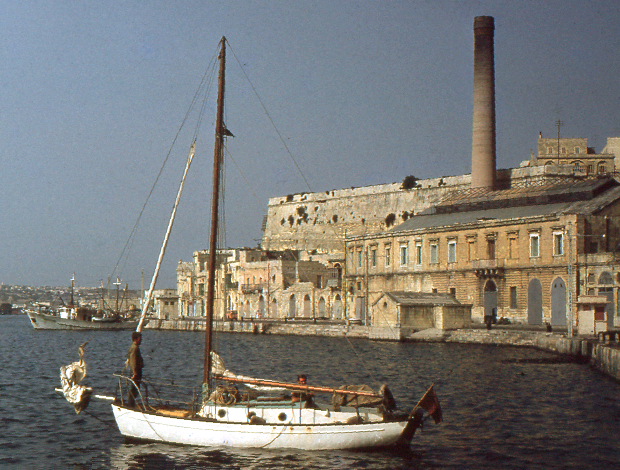
Ganga Devi photographed in Grand Harbour, Valetta; the first port
of call after passage through the Suez Canal on her impressive voyage
from Hong Kong to the UK in 1961
With insufficient time to complete the voyage via Gibraltar, we headed for Sete to take the short cut through the Canal du Midi and the Canal Lateral a la Garonne to Bordeaux. There are 153 locks on this route and at that time most were manually operated. Whilst taking Ganga Devi's mast down we met Geoff Scott, a delivery skipper who was taking the Hillyard ketch Sea Fairey from Nice to Salcombe. It was agreed that he would tow us all the way through the canals if we worked the locks, a happy arrangement as both parties were in a hurry. On one gruelling day 40 locks were traversed. The passage took five days as a result; locals assured us this was a record.
At the Bordeaux Yacht Club on 1st July 1961 the mast was rerigged before, the next day, taking the ebb down the River Gironde to Royan. Here I sent a telegram to the MOD forecasting our arrival around mid July. To my surprise, an immediate reply ordered us to report to Falmouth at 1100 hours on 10 July. I replied to say that I would do my best and asked that the necessary arrangements be made for the wind to be favourable.
With a deadline to work to, we left in spite of a worrying weather forecast. Biscay was rough initially, but we then had a magnificent week long sail on a broad reach home, making landfall on St Michaels Mount on 8th July. The wind remained fair and at 0015 hours on 10th July I secured to Fish Strand Quay in Falmouth. Extraordinarily, and to our dismay, when we reported our arrival we were unceremoniously towed out to sea again by a harbour launch and reminded that we had been ordered to sail in at 1100 hours that morning. At the allocated time, the reason became clear; our “arrival” was filmed by Getty Images for the BBC, and as we stepped ashore we were photographed and interviewed by several press reporters, the London Times carrying our story the following day.
* * * * *
JOC Alexander sold Ganga Devi within a week of the Falmouth arrival for £600. Eight years later he chartered her back for a week's holiday with his wife Mary. In the next issue of the Journal we'll round off this series with an article from the current owner of Ganga Devi.
~ Book Review ~
Cruising Yachts : Design and Performance
“A H P”
Writing in Yachting World, January 1946
The late Mr T Harrison Butler was a real enthusiast in the cause of yachting. Although naval architecture was necessarily subordinate to the exacting profession of opthalmic surgeon, he produced, in the last twenty years of his life, many designs of yachts of different types, wrote many articles for the yachting Press, and carried on a great volume of correspondence with those who were interested in his work.
He never failed to offer help and encouragement to the young designer and it was with this aim in view that he wrote the original series of articles which later formed the basis of this book. It is a matter of deep regret that he did not live to see his book published and to complete others as he had intended.
Holding strong views about the design of small yachts he would defend them with the utmost zest, yet he was always prepared to admit his mistakes and pass his experience on as a warning to others. As the leading amateur designer of our time who has had many opportunities to put his theories into practice, his views are bound to be of the greatest interest.
The first chapters of the book are devoted to an explanation, in simple terms, of yacht design. He then describes in detail with many helpful suggestions the methods he adopted in producing a design. The advice is delivered with characteristic vigour; “Personally I abominate flats even in the body plan, but one often sees them in the drawing of a bow. Let us have free flowing curves with the reverses melting into the main curve like the curve of a flower”.
And later; “The keynote is accuracy and the sense of a true curve. Never let anything pass that is not perfect. Do not distort a curve, however slightly, to make things match”.
This is excellent advice, but in view of his particular emphasis upon accuracy, it is surprising to find that he makes no mention of a process without which it is extremely difficult to achieve either accuracy or harmony between the fore and after bodies of the hull. The rake curves, i.e. the lines through the optimum points of the curves of the bow and buttock lines, of the waterlines and the diagonals must in each case be a fair curve and must agree with the other two. Many designs fall short of accuracy in this respect and no text book on design is complete without a description of this part of the process of fairing up.
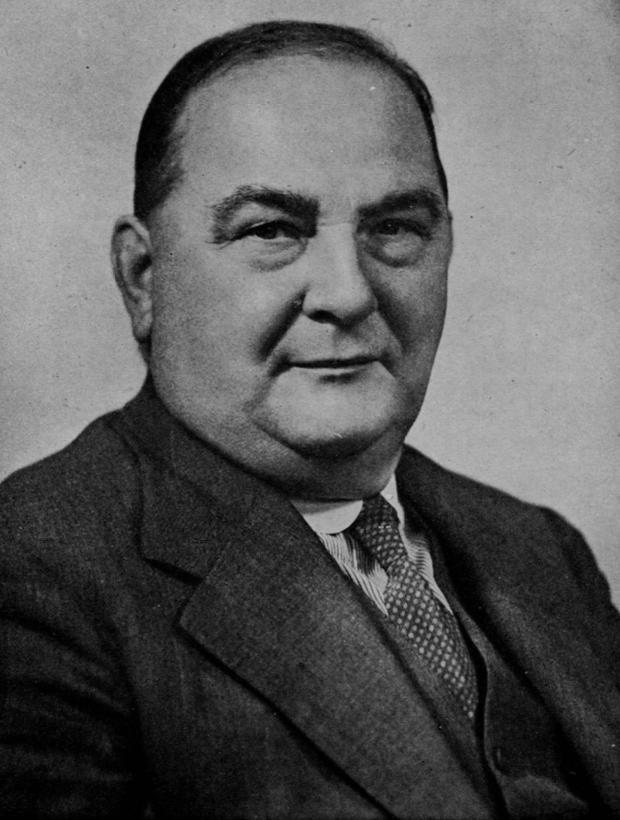
Thomas Harrison Butler
Photograph by HJ Whitlock & Sons Ltd, Birmingham
Generally speaking, the author's methods are sound and have the great virtue of simplicity. It is difficult, however, to agree with the advice that the displacement should not be calculated until the design is finished, for the designer may find that he has produced a hull quite unsuitable for the type of construction he has in mind. It is quite easy to make a rough calculation of the displacement from the preliminary drawings.
A chapter is devoted to ballasting and this includes a most useful description of the method of calculating the weight and centre of gravity of the keel.
Sails are dealt with from both theoretical and practical aspects and much helpful information is given about rigging and gear.
On the question of layout of small cruising yachts the author excels and his general advice is both sound and practical. Lt-Cdr Braithwaite contributes an informative chapter on finding the centre of gravity.
The question of hull balance has caused more misunderstanding and controversy than almost any other in the history of yacht design and Harrison Butler was one of the most ardent champions of the metacentric shelf method. It was with particular interest therefore, that the chapters on this subject were studied. It is admittedly a most difficult subject to set out clearly and so far as the general explanation is concerned the author has achieved a considerable degree of success. In attempting the task of simplifying the mathematics he sometimes strays from precise terminology and so makes it difficult for the beginner to follow the examples given.
The many admirers of Harrison Butler yachts will be glad to find an interesting selection of his designs and also one by his daughter, Mrs Jardine Brown, who completes the book with a very thorough index.
There is something for everyone in Cruising Yachts : Design and Performance and he will be a very experienced designer who cannot learn something of value. The book is well produced and has many illustrations.
* * * * *
The latest fifth edition of Harrison Butler's book, Cruising Yachts : Design and Performance is available from Lodestar Books for £20.
The Classic Boat Letter
John-Henry Bowden
Chairman of The Harrison Butler Association
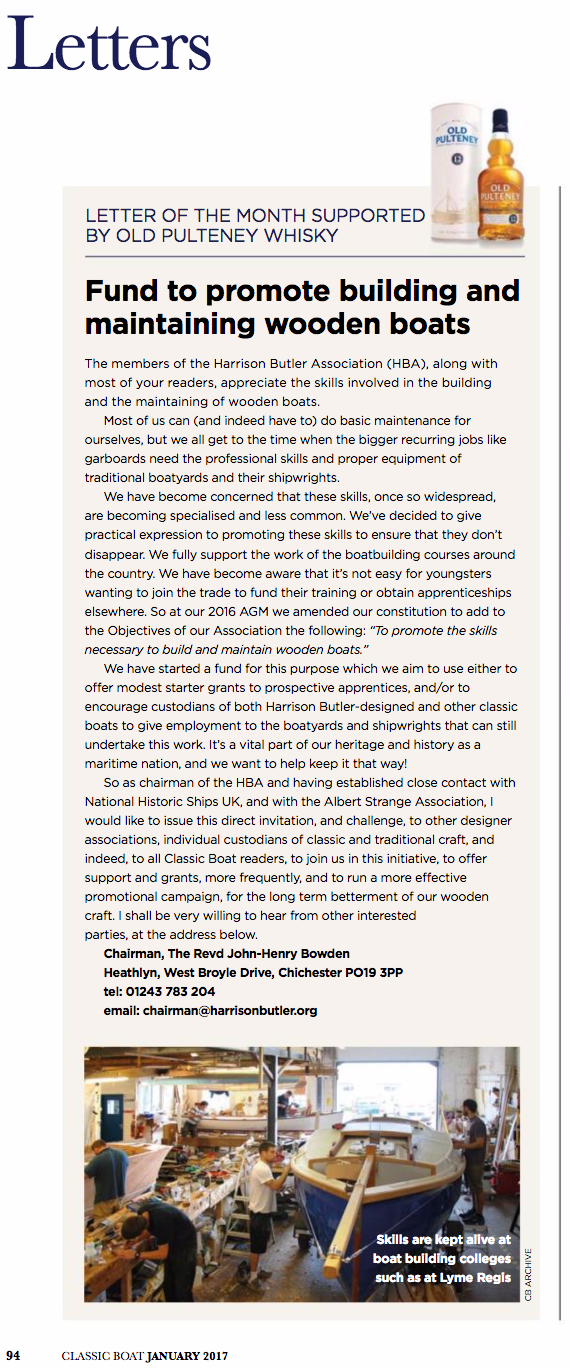
* * * * *
John-Henry's letter is also published in the current April/May issue of Classic Sailor magazine along with the following reply from Editor Dan Houston; “This is a good idea John and we are happy to help with news and features or in any practical way we can”.

Waverly Shipbrush
Winston Megoran was a prolific maritime artist both before and after the second world war. His artwork appeared in Yachting Monthly, The Navy, The Sphere, Pictorial Education, The Fleet, War Weekly, Boy's Own Paper, The Eagle, and many others. His sketches and watercolours became a backdrop to the thriving and technological cutting edge adventurous activity that was sailing during those times. In particular his work was used on the dustcovers of many of the books in The Mariners Library, especially when reissued after the war. These are characterised by an economy of line, block colouring, and have a wonderful dynamic quality; he understood how water worked.
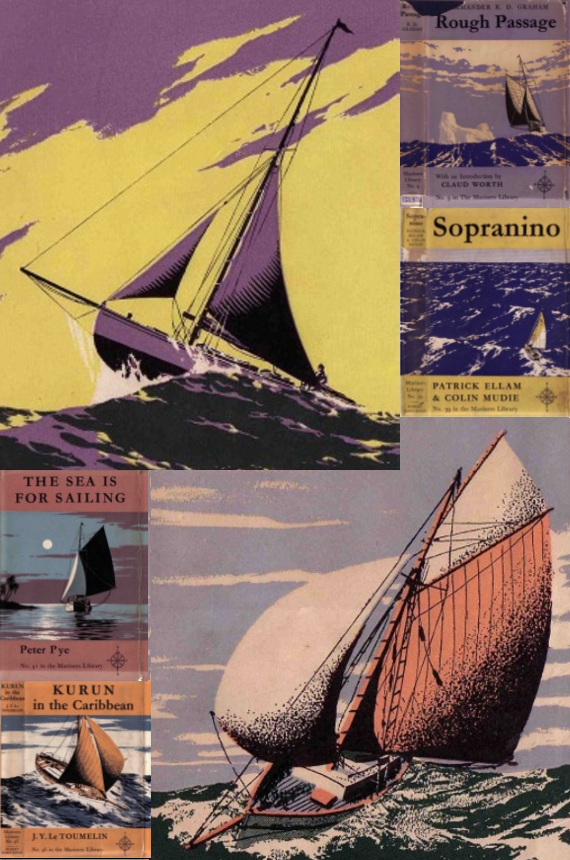
Winston Megoran's artwork on dustcovers
from The Mariner's Library
People Spotted : The 2004 AGM
Paul Leinthall-Cowman
The HBA's Authentication Officer
Old hands will enjoy trying to put names to the faces in this archive photograph of the 2004 AGM attendees. It was taken by Keith Band at The Bull, opposite OJJB's home The Chestnuts, Theale, Reading. If you want a few clues, amongst those assembled are Mark Miller, Jill Betts, Peter Crook, Elspeth Macfarlane, Janet Band, and several previous Chairmen of the Association.
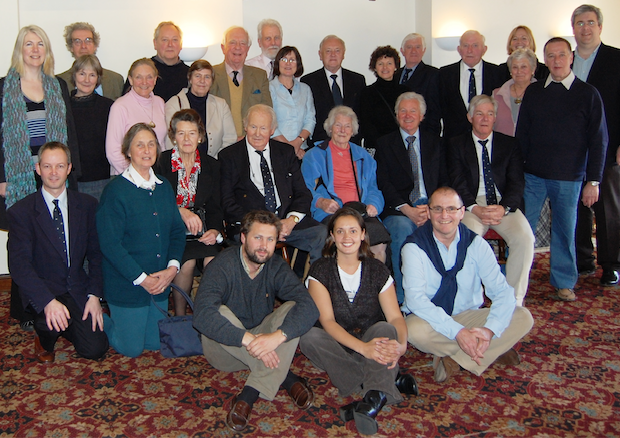
Group Shot of the 2004 AGM
Photograph by Keith Band

HB = Harrison Butler Designed
AS = Albert Strange Designed
IF = Invited Friend - The link will give designer detail
Caracole : HB Bogle Design : 1934 : Portsmouth,UK : £15,000
Cyclone : HB Cyclone Design : 1941 : Netherlands : £12,100
Isabella : HB Omega Design : 1984 : Australia : £15,300
Jacaranda : HB Z4 : 1938 : Frankfurt, Germany : £2,800
Jane : HB Bogle Design : 1939 : Cornwall, UK : £10,000
Jolanda : HB Omega Design : 1996 : Germany : £28,400
La Bonne : HB Nursery Class : 1919 : Devon, UK : £POA
Quest of Sydney : HB Vindilis Design : 1936 : Queensland, Australia : £POA
Saltwind : HB Z4 : 1940 : Spain : £19,900
Sea Harmony : AS : 1937 : Massachusetts, USA : £25,000
Senorita : HB Cyclone II Design : 1934 : New Zealand : £4,000
Tamaroa : HB Thuella Design : 1973 : £9,000
Tally Ho : AS : 1909 : West Coast, USA : £25,000
Thule : HB Yonne Design : 1934 : Netherlands : £17,700 -£22,200
Watermaiden : HB Rose of Arden : 1939 : Cornwall : £15,950
Witte Walvis : HB Z4 : 1939 : Netherlands : £5,000
Zebedee : HB Z4 : 1938 : Ireland : £4,750
Zircon : HB Z4 : 1938 : River Orwell, UK : £7,500
Bring Tally Ho Home
Lee Shore
The Albert Strange Association (ASA) has taken the brave and bold decision to use almost all Association funds to try to save the Albert Strange designed vessel Tally Ho, winner of the 1927 Fastnet race. For a couple of years, a “white knight” has been sought who'd relish the challenge of restoring the historically important ship, but with no hero on the horizon and a boatyard threatening to cut her up if not moved, the Association is stepping in. Alas, the ASA's funds do not come close to the £30,000 needed to transport Tally Ho back to the UK, to bring her home. Undaunted, they have launched a fundraising campaign that has raised £2,860. This is sufficient to move her, although 'not far'.
The rescue options were the prime focus of the 2017 AGM, held in Scarborough where Albert was Headmaster of the Art School . The decision to step in financially is a noble way of marking the 100th anniversary of the end of Albert's life.
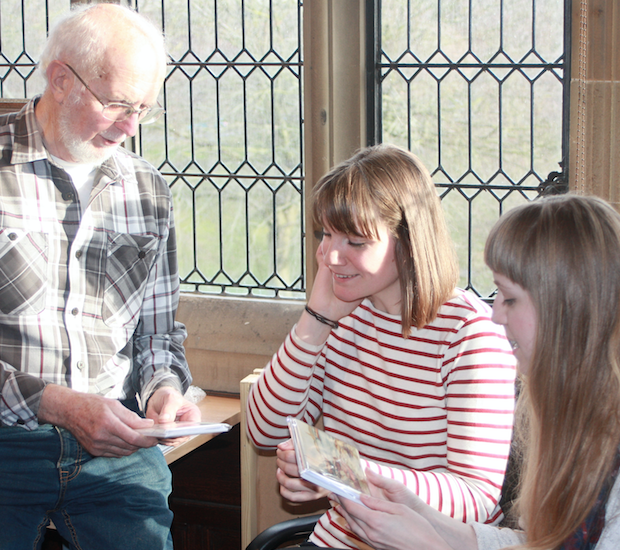
Russell Read shows off a pack of six Greeting Cards,
depicting maritime paintings by Albert Strange,
to two of Albert's great, great, grand-daughters, Laura and Amy,
at the Albert Strange Association's 2017 AGM.
Photograph by Martin Hansen

| |